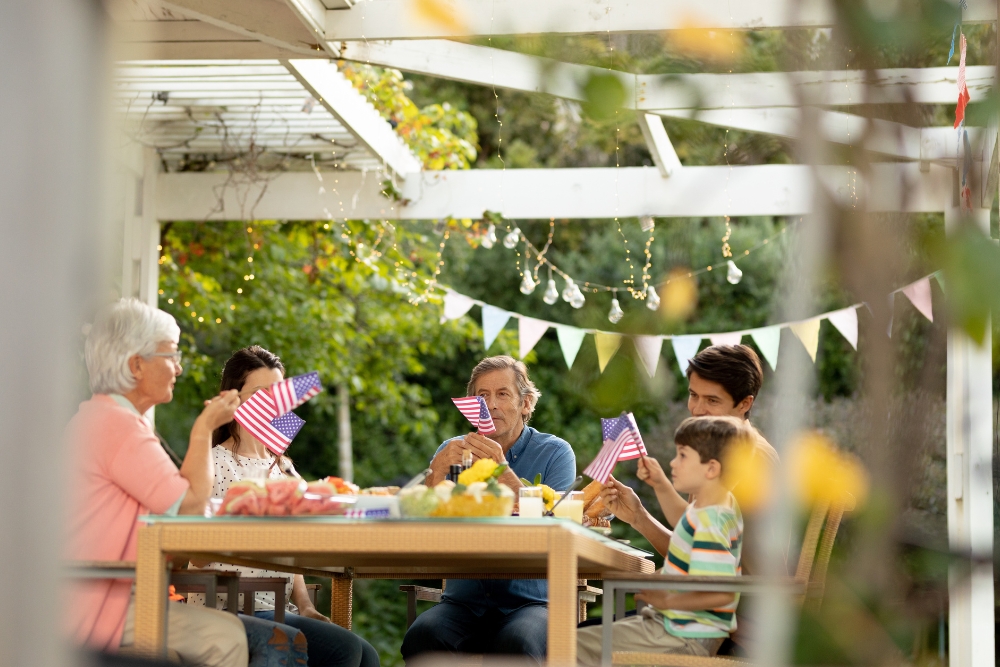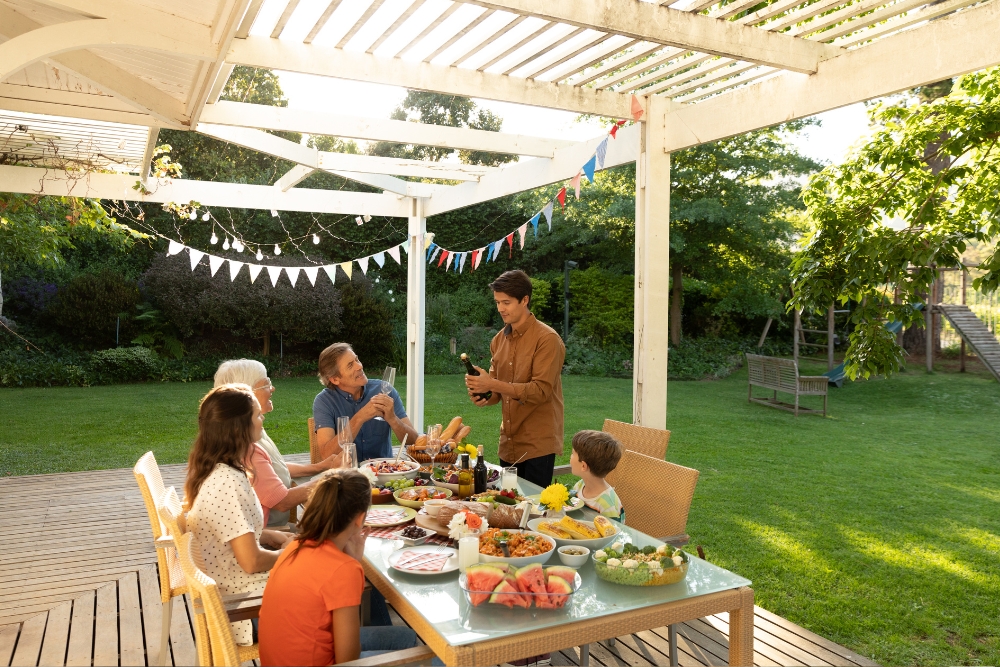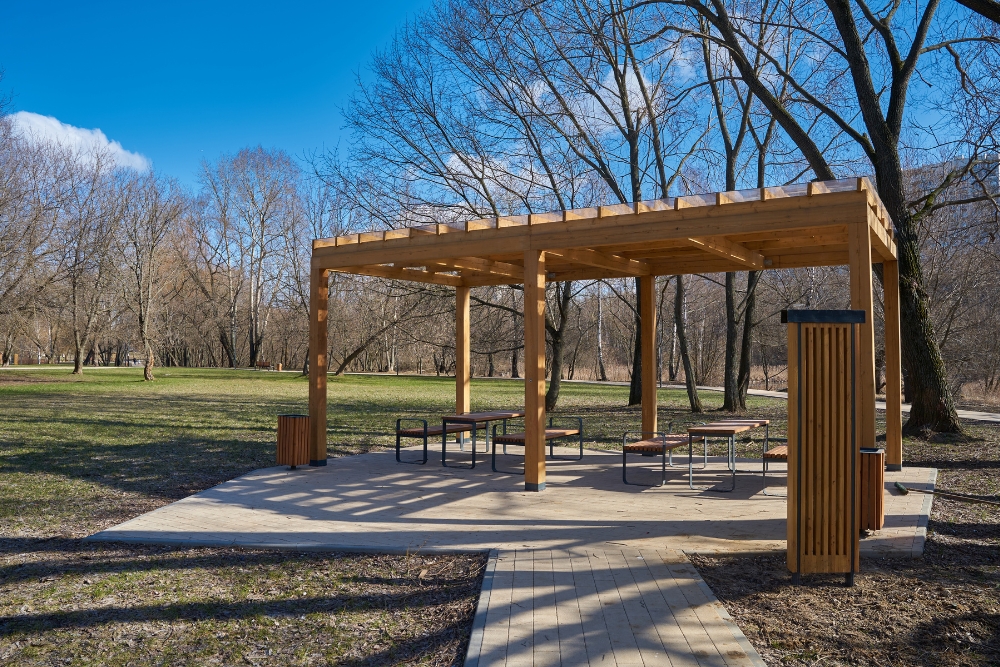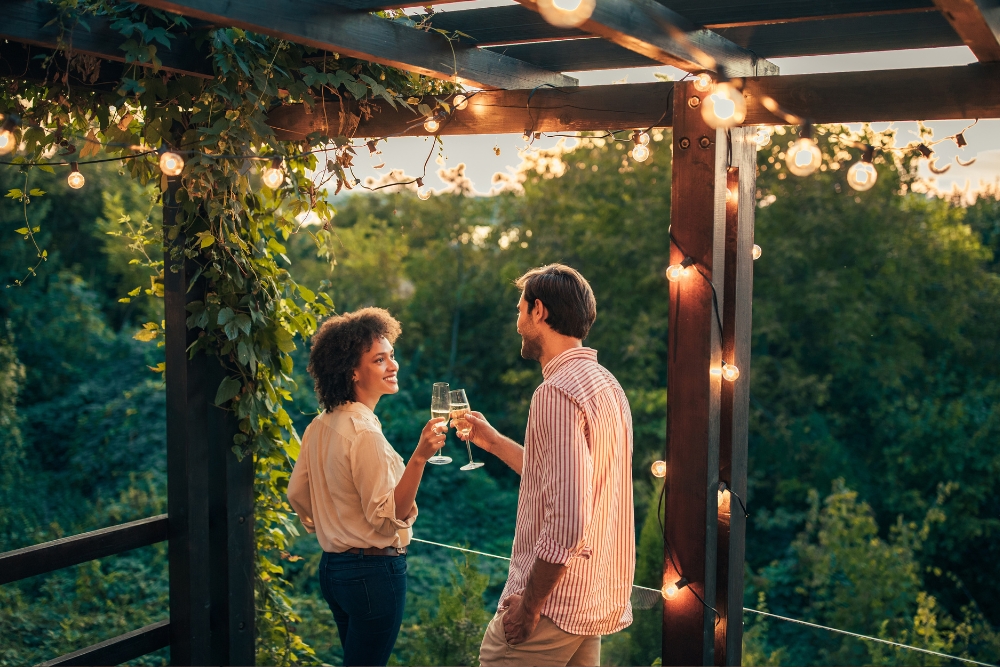Coping with the relentless Aussie sun can be a right stinker, especially when you’re trying to enjoy your backyard without melting into your deck chair. We know all too well the struggle of finding a shade that doesn’t break the bank or look like an eyesore in your outdoor space.
Our journey has led us to uncover some ripper ideas involving wooden pergolas — by adding a touch of savvy design nous, they become brilliant heat-beaters. This yarn is all about guiding you through setting up a shady nook with pergola designs that are not only smart but dead-set stylish as well.
Key Takeaways
- Wooden pergolas can significantly increase comfort in hot climates by providing essential shade and allowing for natural airflow.
- When designing pergolas for these environments, it’s important to consider orientation, form, and materials like weather-resistant timber or composite materials that offer durability and low maintenance.
- Incorporating adjustable louvres, climbing plants, and water features into a pergola design can enhance its cooling effects while also adding aesthetic value to an outdoor space.
- Regular upkeep such as cleaning and sealing wood is crucial for the longevity of a pergola in dry climates; understanding the costs of both building your own or purchasing a pre-made structure helps in making informed decisions based on budget and preferences.
Passive Design Strategies for Hot and Dry Climates
Understanding passive design strategies is crucial for creating comfortable and energy-efficient living spaces in hot and dry climates. By considering building orientation, ventilation, daylighting, shading, and the use of suitable materials, homeowners can effectively mitigate the challenges posed by extreme heat.

Understanding Passive Design Strategies
Passive design strategies are our secret weapon against the sweltering heat. By tapping into natural resources, we cool our homes without relying too much on air conditioning. A keen focus on shade structures, like outdoor timber pergolas for hot climates, makes a big difference in how comfortable our spaces feel.
We use clever positioning and materials that reflect or absorb heat to keep temperatures down.
Incorporating features such as louvred pergolas helps us manage sunlight exposure, allowing breezes to flow through while blocking out unwanted heat. Wooden pergolas not only offer an effective shading solution but also support climbing plants, adding beauty and further cooling effects.
This approach blends function with style, leveraging sustainable building materials to create soothing outdoor havens even when the mercury rises. Now let’s dive deeper into the principles and importance of these life-saving design choices.
Principles and Importance
Understanding the principles and importance of strategic pergola design is crucial for creating a comfortable outdoor oasis in hot climates. By incorporating effective shading structures and materials, such as weather-resistant timber or innovative louvred designs, homeowners can significantly reduce heat exposure and create a pleasant environment.
Moreover, recognising the significance of promoting airflow through well-designed gazebos and using natural earth-cooling techniques can further enhance the overall thermal performance of outdoor spaces, ensuring that they remain cool even in extreme temperatures.
Furthermore, acknowledging the valuable role that pergolas play in providing shade and aesthetic value to outdoor areas can help homeowners make informed decisions about incorporating these essential elements into their landscape design.
With modern sustainable pergola designs tailored to hot climates gaining popularity, it’s clear that strategic timber pergola design is not only stylish but also an effective way to keep cool while enjoying outdoor living.
Characteristics and Challenges of Hot and Dry Climates
Hot and dry climates pose unique challenges when it comes to outdoor living spaces. The intense heat and minimal rainfall require strategic design solutions to ensure comfort and functionality.
In these climates, excessive sun exposure can lead to discomfort and potential overheating, making shade an essential characteristic of any outdoor structure. Additionally, the lack of moisture in the air can create a parched environment that may impact both vegetation and materials used in construction.
When designing for hot and dry climates, it’s crucial to consider passive strategies that promote cooling while also mitigating the effects of harsh sunlight. Understanding how orientation, ventilation, shading, and material choices play a role is vital for creating comfortable outdoor areas in these challenging environments.
Key Design Strategies for Building in Hot and Dry Climates
When building in hot and dry climates, it’s crucial to consider the orientation and form of the structure to maximise shade and ventilation. Using materials that have high thermal mass and insulating properties can help regulate indoor temperatures while incorporating water elements for cooling can also be effective.
It’s important to integrate these design strategies to create comfortable living spaces in hot and dry climates.
Building Orientation and Form
When designing a pergola for hot climates, the orientation and form of the structure are crucial. Placing the pergola in a way that maximises shade during peak sun hours can significantly impact the comfort of the outdoor space.
Additionally, choosing an open and airy form for the pergola allows for better airflow, contributing to a cooler environment. By strategically designing the orientation and form of your pergola, you can create a comfortable oasis in even the hottest climates.
Moving on from building orientation and form, let’s delve into another important aspect – ventilation and openings to ensure a well-ventilated outdoor space.
Ventilation and Openings
- Positioning windows strategically to encourage cross-ventilation and allow hot air to escape while bringing in cooler air.
- Installing adjustable louvres or vents to control airflow and maximise natural cooling effects.
- Using ceiling fans to enhance air circulation and create a refreshing breeze within the pergola.
- Incorporating open sides or partial walls to promote airflow while providing privacy and shade.
- Utilising pergola designs that incorporate skylights or translucent roofing materials to allow natural light while minimising heat gain.
- Selecting materials that facilitate airflow, such as timber lattice panels or slatted screens, to maintain a cool environment under the pergola.
- Implementing operable shades or curtains that can be adjusted to regulate sunlight and airflow, effectively managing the temperature within the space.
- Introducing climbing plants around the pergola to create a living canopy that naturally filters sunlight and cools the surrounding area without obstructing airflow.
Daylighting and Shading
In hot climates, maximising daylight while providing adequate shading is crucial for creating a comfortable outdoor space. Here are some key strategies to achieve this:
- Incorporate large windows and skylights to maximise natural light while ensuring proper shading to prevent overheating.
- Use light-coloured and reflective surfaces to bounce sunlight into the space and reduce the need for artificial lighting.
- Install adjustable shading devices such as blinds, curtains, or exterior shades to control the amount of sunlight entering the space throughout the day.
- Consider strategically placed landscaping elements like trees and shrubs to provide natural shading while maintaining a connection to nature.
- Utilise pergolas with louvred roofs or retractable canopies that can be adjusted to control the amount of shade and sunlight entering the outdoor area.
- Implement overhangs or eaves on buildings to protect windows and outdoor living spaces from direct sunlight, reducing heat gain inside the home.
- Opt for shading structures with weather-resistant materials that can withstand harsh climatic conditions, ensuring longevity and durability.
- Explore innovative shading solutions such as solar-powered motorised shades or architectural features designed specifically for hot climates.
Use of Materials
Moving on from sheltering the space with effective shading and natural light, our next focus is on the choice of materials for constructing pergolas in hot climates. Opting for weather-resistant timber or durable composite materials can ensure longevity and low maintenance.
This approach aligns with modern louvred pergola designs that are both watertight and robust enough to withstand extreme weather conditions. By selecting these sturdy, high-quality materials, we can create sustainable and energy-efficient shading solutions that enhance our outdoor living spaces.
Water as a Cooling Element
When considering strategic design elements for cooling in hot climates, incorporating water features can be a game-changer. From small fountains to larger ponds or pools, the evaporation process naturally cools the surrounding air, providing a refreshing oasis in your outdoor space.
Additionally, designing open-air misting systems around pergolas or structures can further enhance the cooling effect of water elements while providing an enjoyable atmosphere during scorching days.
Strategic positioning of water features near pergolas or outdoor seating areas allows for efficient heat dissipation and creates a more comfortable environment. Utilising these water-based cooling solutions not only combats high temperatures but also adds a relaxing and tranquil ambience to your outdoor living spaces.

Incorporating Pergolas in Hot and Dry Climates
Pergolas are a great addition to hot and dry climates, offering shade and a cool outdoor space. By choosing the right materials and incorporating greenery, you can create a comfortable and stylish pergola design that complements your home.
Read on to learn more about the benefits of pergolas in hot climates and how to choose the perfect design for your outdoor space.
Benefits of Pergolas in Hot and Dry Climates
Pergolas provide essential shade and relief from the intense heat in hot and dry climates, making outdoor spaces more comfortable to enjoy throughout the year. These shading structures play a crucial role in creating a cooler environment by blocking direct sunlight, while still allowing for natural airflow.
By strategically incorporating pergolas into outdoor areas, homeowners can significantly reduce the impact of harsh sun exposure and create a pleasant oasis for relaxation.
The strategic design of wooden pergolas not only offers effective sun protection but also adds aesthetic value to outdoor spaces in hot climates. With innovative materials and construction techniques, modern pergolas are designed to withstand extreme weather conditions while providing sustainable and stylish shade options for homeowners.
Tips for Choosing Pergola Materials
In addition to understanding the benefits of pergolas in hot and dry climates, choosing the right materials is essential for achieving an effective and sustainable design. Here are some tips for selecting the most suitable pergola materials:
- Opt for weather-resistant timber that can withstand extreme temperatures and humidity without warping or deteriorating, ensuring longevity and durability.
- Consider using sustainable and eco-friendly materials such as bamboo or reclaimed wood to minimise environmental impact while enhancing the aesthetic appeal.
- Choose materials that require minimal maintenance in hot climates, such as aluminium or vinyl, to avoid constant upkeep and prolong the lifespan of your pergola.
- Prioritise materials with natural cooling properties, like cedar or redwood, which can help regulate temperature and create a comfortable outdoor environment.
- Select materials that complement your local climate and architectural style, ensuring seamless integration with your existing outdoor space while maximising aesthetic cohesion.
- Research the thermal properties of different materials to choose ones that provide effective insulation against heat transfer, helping to keep your pergola area cool during hot weather.
- Explore innovative composite materials that offer a balance between durability, aesthetics, and low maintenance requirements for long-term performance in hot climates.
- Consult with professional designers or architects knowledgeable about hot climate construction to gain insights into the best material options suited for your specific location.
Different Types of Pergola Designs
Wooden pergolas and timber gazebos are popular choices for hot climates, offering various design options to suit different preferences and needs. Here are some popular types of pergola designs to consider:
- Traditional Open-Top Pergolas: These classic designs feature open roofing with beams and rafters, allowing sunlight to filter through while providing partial shade.
- Louvred Pergolas: With adjustable slats or louvres, these pergolas offer control over sunlight exposure, allowing for customised shade and ventilation.
- Attached Pergolas: Ideal for extending the living space, these pergolas attach directly to the home, seamlessly blending indoor and outdoor areas.
- Freestanding Pergolas: These standalone structures can be strategically placed in the landscape to create designated outdoor living spaces away from the main house.
- Arched or Curved Pergolas: Adding a touch of elegance, arched or curved pergolas soften the lines of outdoor spaces and provide visual interest.
- Retractable Canopy Pergolas: Featuring retractable fabric or canopy coverings, these pergolas offer versatility by providing shade when needed and openness when desired.
- Modern Minimalist Pergolas: Sleek and understated in design, these minimalist structures complement contemporary architecture while providing functional shade solutions.
Incorporating Greenery and Vines in Pergola Design
For homeowners looking to enhance their outdoor space, incorporating greenery and vines in pergola design can create a beautiful and refreshing environment. By strategically weaving climbing plants through the pergola structure, not only can you achieve natural shade and cooling effects, but also add a touch of lush greenery to your outdoor area.
This integration of flora not only softens the structure’s appearance but also brings life to the surroundings.
Vines wrapping around wooden pergolas act as a natural sunscreen, providing an additional layer of protection from harsh sunlight while creating a picturesque setting with vibrant foliage.
Maintenance and Cost Considerations
When it comes to maintaining a pergola in hot and dry climates, regular cleaning and sealing of the wood are essential to protect it from the harsh elements. It’s also important to consider the cost of building versus buying a pergola, as well as any additional maintenance expenses that may arise.
Tips for Maintaining a Pergola in Hot and Dry Climates
Maintaining a pergola in hot and dry climates is essential for its longevity and appeal. Here are some tips for keeping your pergola in top condition:

- Regularly clean the structure to remove dust, dirt, and debris.
- Inspect the wood for signs of rot or decay, and treat any affected areas promptly.
- Apply a protective sealant or stain to the wood every 1 – 2 years to prevent sun damage and moisture penetration.
- Trim back any overgrown vines or plants to prevent them from causing damage to the structure.
- Check for loose or damaged hardware such as screws, bolts, and brackets, and replace as needed.
- Monitor for signs of insect infestation and take appropriate measures to address any pest issues.
- Consider installing retractable shade covers to provide additional protection from intense sun exposure.
- Ensure proper drainage around the base of the pergola to prevent water pooling and potential damage to the foundation.
- Periodically inspect the roofing materials for wear and tear, repairing or replacing them as necessary.
- Invest in regular professional inspections and maintenance to identify any potential issues early on.
Cost Comparison of Building versus Buying a Pergola
When deciding whether to build or buy a pergola, especially in the hot climates we often experience here in Australia, it’s important for us as homeowners to consider the costs involved. Building your own pergola can be a rewarding DIY project with potential savings, but purchasing a pre-made kit or a custom design can save time and offer advanced features. Let’s look at a simplified cost comparison between the two options:
| Cost Factor | Building a Pergola | Buying a Pergola |
|---|---|---|
| Materials | Labour | Typically higher due to pre-fabrication and quality control. |
| DIY is free but time-consuming; hiring a professional adds to the cost. | Included in the price; installation may be extra. | Depends on the building expertise and materials used. |
| Design | Depends on the building expertise and materials used. | Pre-designed, with a range of styles and features to choose from. |
| Tools | Must be purchased or rented if not already owned. | Not required for pre-made pergolas. |
| Time Investment | A significant amount of time is needed for planning and construction. | Minimal, mostly for shopping and decision-making. |
| Longevity and Durability | Depends on building expertise and materials used. | Often comes with a warranty; materials are engineered for durability. |
| Overall Cost | Can be lower, but with the risk of unexpected expenses. | Generally higher but with clear upfront costs. |
We always encourage careful consideration of not only initial costs but also long-term value and enjoyment of your outdoor space. Opting for a pergola, whether built or bought, will provide much-needed shade and can enhance your garden’s livability, especially during hot summers. Choose the option that aligns best with your budget, time, and skills.
Latest Trends in Pergola Design for Hot and Dry Climates
Modern pergola designs for hot and dry climates focus on incorporating sustainable and eco-friendly materials, providing effective shading solutions, and optimising ventilation. Creative use of weather-resistant materials like timber and louvred structures helps in withstanding extreme weather conditions while creating a cool outdoor oasis.
Incorporating greenery, such as climbing plants, not only adds aesthetic appeal but also enhances the cooling effect by providing natural shade. Additionally, integrating innovative shading options into pergola designs ensures comfortable outdoor spaces even during the hottest days.
Furthermore, strategic design elements are being employed to maximise the functionality of pergolas in hot climates. For example, adjustable louvres or retractable canopies are increasingly popular features that allow homeowners to control sunlight exposure based on their preferences.
Sustainable and Eco-Friendly Design Options
Transitioning from the latest trends in pergola design for hot and dry climates, let’s delve into sustainable and eco-friendly design options. When considering sustainable design options for your pergola, incorporating greenery and vines can offer natural shade while contributing to a lush outdoor environment.
Utilising weather-resistant, energy-efficient materials can help create an eco-friendly structure that withstands extreme weather conditions while reducing environmental impact.
Choosing sustainable and eco-friendly pergola designs not only benefits the environment but also enhances the overall appeal of your outdoor space. Strategic timber pergolas integrated with climbing plants provide effective shading solutions for hot climates, creating a comfortable and enjoyable oasis while promoting energy efficiency.
Importance of Proper Design and Construction for Longevity
Transitioning from sustainable and eco-friendly design options to the importance of proper design and construction for longevity, it’s crucial to consider the lasting impact of your pergola.
Strategic timber pergola design plays a vital role in ensuring that your outdoor structure withstands the test of time in hot climates. By using weather-resistant materials and considering the overall climate conditions, you can enhance the durability of your pergola, allowing it to provide cooling shade for years to come.
Understanding the benefits of strategic pergola design is essential for creating a comfortable outdoor oasis that not only offers relief from the heat but also adds aesthetic value to your outdoor space.
Tips for Creating a Comfortable and Enjoyable Outdoor Space.
To create a comfortable and enjoyable outdoor space, consider strategic pergola design as an effective way to provide shade and coolness in hot climates. Here are some tips to help you maximise the comfort of your outdoor oasis:
- Choose a strategic location for your pergola to maximise shade and airflow while considering the path of the sun throughout the day.
- Incorporate natural elements such as climbing plants and vines to enhance shade and create a lush, green environment.
- Opt for weather-resistant materials that can withstand extreme weather conditions while maintaining their aesthetic appeal.
- Utilise modern louvred pergolas that can be adjusted to control sunlight and ventilation according to your specific needs.
- Consider incorporating water features alongside your pergola to create a cooling effect and add visual appeal to your outdoor space.
- Ensure regular maintenance of your pergola structure and surrounding vegetation to uphold its functionality and aesthetic beauty.
- Plan for adequate seating and relaxation areas within the shaded space for maximum comfort during hot weather.
- Embrace sustainable design options, such as using eco-friendly materials or integrating solar-powered lighting to enhance your outdoor space.
Aluminum Pergolas: Enhancing Your Space’s Charm!
In conclusion, it’s clear that strategic design and proper construction of wooden pergolas can greatly improve the comfort and functionality of outdoor spaces in hot climates. With the right materials, shading options, and incorporating greenery into the design, homeowners can create a cool and enjoyable oasis to relax and entertain in.
It’s important to stay updated on the latest trends and sustainable design options to make the most out of your outdoor space.
Discover the perfect solution for hot climates with Wooden Pergolas! Crafted with strategic design, our Wooden Pergolas offer not just shade but also a cool retreat from the scorching sun. Experience the bliss of outdoor living while staying comfortably cool. Upgrade your outdoor space with Wooden Pergolas today and beat the heat in style! Contact Us Now!




